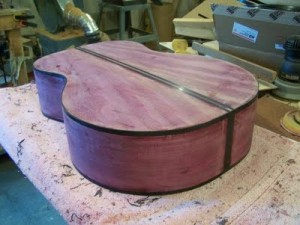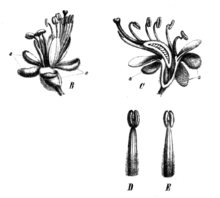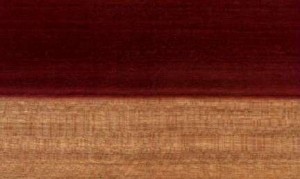Purpleheart
A good pictorial detailing this purpleheart guitar’s construction here.
Trade Names:
Purpleheart , Amaranth
Taxonomy:
Kingdom: Plantae – Plants
Subkingdom: Tracheobionta – Vascular plants
Superdivision: Spermatophyta – Seed plants
Division: Magnoliophyta – Flowering plants
Class: Liliopsida – Magnoliopsida – Dicotyledons
Subclass: Rosidae
Order: Fabales
Family: Fabaceae – Pea family
Genus: Peltogyne
Species: porphyrocardia, venosa, paniculata, and others.
Janka Hardness (pounds-force): 2390
For all you botanists out there, Peltogyne paniculata, according to Wikipedia.
Description:
Purpleheart refers to many of the species from the Genus Peltogyne. When cut, the heartwood appears dull gray/purple-brown. Once exposed, it turns into its vibrant trademark purple. Over time, this color can fade, but the striking violets can be somewhat retained using a high-quality UV inhibitor. Purpleheart has generally straight grain, but irregularities are common. Texture is medium, while the pores are tight.
Location:
Central and South America, namely: Bolivia, Brazil, Colombia, French Guiana, Guyana, Mexico, Venezuela, Suriname
Further information is found here, as seen in the Wood Explorer database.
Common Aliases:
Amarante, Amaranth, Barabu, Bois violet, Ellongrypho, Kooroobovelli, Koroborelli, Lastan, Morado, Palo morado, Pao violeta, Pau roxo, Pelo morado, Saka, Sakavalli, Violetwood.
Performance:
Purple is very durable against rot and insect infestation. Keep your tools sharp when working purpleheart, as the wood becomes gummy when it becomes too hot. Like I said before, it’s an interesting wood…
Affordability:
$$$ Purpleheart is a relatively affordable and widely available specialty wood in the United States.
Common Uses:
Audio equipment, billiard cues, bridges, millwork, skis, sporting goods, wharf construction, specialty guitars, veneers, furnishings, cabinetry, small wooden craft items.
From: The Wood Database:
Common Name(s): Purpleheart, Amaranth
Scientific Name: Peltogyne spp.
Distribution: Central and South America (from Mexico down to southern Brazil)
Tree Size: 100-170 ft (30-50 m) tall, 3-5 ft (1-1.5 m) trunk diameter
Average Dried Weight: 61 lbs/ft3 (980 kg/m3)
Basic Specific Gravity: .79
Hardness: 2,390 lbf (10,630 N)
Rupture Strength: 22,000 lbf/in2 (151,700 kPa)
Elastic Strength: 2,586,000 lbf/in2 (17,830 MPa)
Crushing Strength: 13,350 lbf/in2 (92.1 MPa)
Shrinkage: Radial: 3.2%, Tangential: 6.1%, Volumetric: 9.9%, T/R Ratio: 1.9


